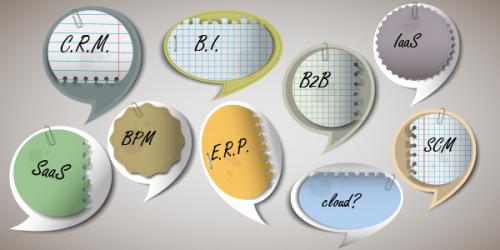If your business has grown to the point you need “next level” finance and business management software you may have stumbled on a number of acronyms and technical terms that can be quite confusing. In this blog, we’ve tried to clarify as many business buzzword and/or acronyms we can think of.
The Cloud
If you’re still not entirely sure what “The Cloud” is we’ll try and explain it. The cloud is accessed via the internet. It is where a network of third-party companies with servers host your data and software over the internet. This means you can access your information from anywhere with a username and password. This allows you to minimize your hardware costs as you don’t need your own servers etc. The host guarantee back-ups of your data. Put simply your data and software is on someone else’s server which you access via the internet.
CRM
If you have customers you may have stumbled on CRM or Customer Relationship Management is software that is used to manage the entire selling process from lead, opportunity, quote and all the way through to the converted customer. It basically facilitates customer service. The software manages your contact information and allows you to track sales opportunities, forecast likely sales, and save documents and emails against each opportunity. What’s the difference between a lead and an opportunity? A lead is a contact that has not been qualified. An opportunity is a lead that has been qualified. I.e. they have confirmed they are looking and their needs fit your product or service. A CRM solution enables management to track trends, sales via person or location, purchase patterns and so on.
ERP
Enterprise Resource Planning is a system that is able to manage all aspects of your business in one integrated system enabling management to get ‘live’ reports. Modules usually include financials, inventory or wholesale distribution, manufacturing, job costing, CRM, reporting, planning, human resources and more. Having all business modules integrated allows workflow streamlining, more efficient processes, custom reports for management. You only need to purchase the modules that suit your business and there are many other add-ons that can be integrated. ERP solutions must be implemented by a partner/ reseller. Partners scope all business processes to ensure the system being implemented fits your business exactly. Usually, during this process, there will be a number of opportunities to automate and refine processes. Existing data is imported into the system and then tested thoroughly to ensure the results are the same. Processes are documented, and thorough training is provided. You cannot purchase an ERP “off the shelf” and you can’t install it “out of the box”.
BI
Business Intelligence. The term Business Intelligence refers to applications that capture data, integrated from numerous ERP modules that analyse and present relevant operational data in a report format enabling management to make sound business decisions. BI is often included to some degree in ERP solutions, but you can get specialised BI applications that increase the capability of the ERP reporting.
SaaS
Software as a Service means an application that is available for users over the internet. I.e. In the Cloud. Applications run remotely and the user access it through their web browser via a login. Examples are Zoom, Office 365, and TeamViewer.
IaaS
Infrastructure as a Service means that a provider is allowing you to hire their computing power through the internet from your own computer or device. For example Dropbox, your own website host, Google Docs or Amazon Web Services.
We hope this dispels some of the confusion surrounding Business software acronyms. If you are considering upgrading to an ERP solution Momentum Software Solutions have the experience and knowledge required to ensure you get a system that is tailored exactly to your business requirements. Call us for a no-obligation chat.
Below is a list of other acronyms you might find useful.
- AES Automated Export System
- AFR Advanced Financial Reporting
- AMM Advanced Material Management
- AP Accounts Payable
- APM Advanced Print Management
- APS Advanced Planning & Scheduling
- AR Accounts Receivable
- B2B Business to Business
- B2C Business to Consumer
- BAQ Business Activity Query
- BAS Business Activity Statement
- BOO Bill of Operations
- BOM Bill of Materials
- BPM Business Process Management
- CAD Computer-Aided Design
- CAM Customer Account Manager
- CMI Customer-Managed Inventory
- COO Country of Origin
- CTP Capable to Promise
- DMT Data Migration Tool
- DMR Discrepant Material Request
- EA Each
- EDI Electronic Data Interchange
- EFT Electronic Funds Transfer
- EPM Enterprise Performance Management
- EQA Enhanced Quality Assurance
- FIFO First In First Out or Fly in Fly Out
- FOB Free on Board
- GL General Ledger
- Go Live Begin transactions in production database
- HCM Human Capital Management
- HH Hand Held
- IM Inventory Management
- KO Kick Off
- MDPV Maximum Daily Production Value
- MES Manufacturing Execution System
- MFG Manufacturing
- MOM Method of Manufacturing
- MPS Master Production Schedule
- MRB Material Review Board
- MRP Material Requirements Planning
- MSA Measurement System Analysis
- MTL Material
- PDM Product Data Management
- PLM Product Life Cycle Management
- PM Project Manager
- PO Purchase Order
- QA Quality Assurance
- RFQ Request for Quote
- RMA Return Material Authorization
- SCM Supply Chain Management
- SMI Supplier Managed Inventory
- SO Sales Order
- SOA Sales Order Acknowledgement
- SRM Supplier Relationship Management
- SSRS SQL Server Reporting Services
- SQL Structured Query Language
- SUB Subcontract
- T&E Time and Expense
- UAT User Acceptance Testing
- UOM Unit of Measure
- WF Workflow
- YE Year End
